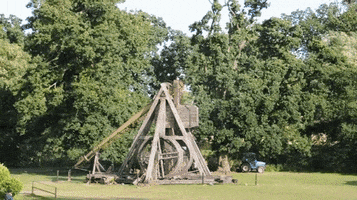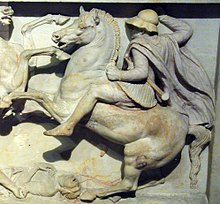Kath wrote:But what's up with biathlon? It's skiing and shooting. Sort of like swimming and then shooting some hoops. I don't get it.
In the original games, the sports were always related to the military.
https://en.wikipedia.org/wiki/Hoplitodromos
The hoplitodromos or hoplitodromia (Greek: Ὁπλιτόδρομος, Ὁπλιτοδρομία, English translation: "race of soldiers") was an ancient foot race, part of the Olympic Games and the other Panhellenic Games. It was the last foot race to be added to the Olympics, first appearing at the 65th Olympics in 520 BC, and was traditionally the last foot race to be held.[1]
Unlike the other races, which were generally run in the nude, the hoplitodromos required competitors to run wearing the helmet and greaves of the hoplite infantryman from which the race took its name. Runners also carried the aspis, the hoplites' bronze-covered wood shield, bringing the total encumbrance to at least 50 pounds. As the hoplitodromos was one of the shorter foot races, the heavy armor and shield was less a test of endurance than one of sheer muscular strength. After 450 BC, the use of greaves was abandoned; however, the weight of the shield and helmet remained substantial.[2]
Hoplitodromia, Attic red-figured neck-amphora by the Berlin Painter, c. 480–70 BC, Louvre Museum (CA 214).
At Olympia and Athens, the hoplitodromos track, like that of the diaulos, was a single lap of the stadium (or two stades; about 350-400m). Since the track made a hairpin turn at the end of the stadium, there was a turning post called a kampter (καμπτήρ) at each end of the track to assist the sprinters in negotiating the tight turn — a task complicated by the shield carried in the runner's off hand. At Nemea the distance was doubled to four stades (about 700-800m), and at Plataea in Boeotia the race was 15 stades in total.[1]
The hoplitodromos, with its military accoutrements, was as much a military training exercise as an athletic contest. Encounters with squads of expert Persian archers, first occurring shortly before the hoplitodromos was introduced in 520 BC, must have suggested the need for training the Greek armored infantry in fast "rushing" maneuvers during combat. Additionally, the original 400-meter length of the hoplitodromos coincides well with the effective area of the Persian archers' zone of fire, suggesting an explicit military purpose for this type of training.
That's one example of the ancient events.
If we really wanted to be true to the spirit of what the Olympics were about, it would consist only of armed forces personnel competing in events that relate directly to training. Think of the kinds of stories you hear Smitty talking about in grueling forced marches punctuated by fast sprinting followed by shooting. Something like that would technically be closer to the spirit of the games.
Biathlon is literally based on Scandinavian ski infantry, and is pretty damned cool.




